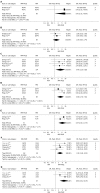Meta-analysis of radiofrequency ablation in combination with transarterial chemoembolization for hepatocellular carcinoma
- PMID: 23840128
- PMCID: PMC3699038
- DOI: 10.3748/wjg.v19.i24.3872
Meta-analysis of radiofrequency ablation in combination with transarterial chemoembolization for hepatocellular carcinoma
Abstract
Aim: To compare radiofrequency ablation (RFA) and transcatheter arterial chemoembolization (TACE) with RFA monotherapy in hepatocellular carcinoma (HCC).
Methods: We searched PubMed, Medline, Embase and Chinese databases (CBMdisc and Wanfang data) for randomized controlled trails comparing RFA plus TACE and RFA alone for treatment of HCC from January 2000 to December 2012. The overall survival rate, recurrence-free survival rate, tumor progression rate, and safety were analyzed and compared. The analysis was conducted on dichotomous outcomes and the standard meta-analytical techniques were used. Pooled odds ratios (ORs) with 95%CIs were calculated using either the fixed-effects or random-effects model. For each meta-analysis, the χ(2) and I(2) tests were first calculated to assess the heterogeneity of the included trials. For P < 0.05 and I(2) > 50%, the assumption of homogeneity was deemed invalid, and the random-effects model was used; otherwise, data were assessed using the fixed-effects model. All statistical analysis was conducted using Review manager (version 4.2.2.) from the Cochrane collaboration.
Results: Eight randomized controlled trials were identified as eligible for inclusion in this analysis and included 598 patients with 306 treated with RFA plus TACE and 292 with RFA alone. Our data analysis indicated that RFA plus TACE was associated a significantly higher overall survival rate (OR1-year = 2.96, 95%CI: 1.84-7.74, P < 0.001; OR2-year = 3.72, 95%CI: 1.24-11.16, P = 0.02; OR3-year = 2.65, 95%CI: 1.81-3.86, P < 0.001) and recurrence-free survival rate (OR3-year = 3.00, 95%CI: 1.75-5.13, P < 0.001; OR5-year = 2.26, 95%CI: 1.43-3.57, P = 0.0004) vs that of RFA alone. The tumor progression rate in patients treated with RFA alone was higher than that of RFA plus TACE (OR = 0.60, 95%CI: 0.42-0.88, P = 0.008) and there was no significant difference on major complications between two different kinds of treatment (OR = 1.20, 95%CI: 0.31-4.62, P = 0.79). Additionally, the meta-analysis data of subgroups revealed that the survival rate was significantly higher in patients with intermediate- and large-size HCC underwent RFA plus TACE than in those underwent RFA monotherapy; however, there was no significant difference between RFA plus TACE and RFA on survival rate for small HCC.
Conclusion: The combination of RFA with TACE has advantages in improving overall survival rate, and provides better prognosis for patients with intermediate- and large-size HCC.
Keywords: Hepatocellular carcinoma; Meta-analysis; Radiofrequency ablation; Transcatheter arterial chemoembolization.
Figures





References
-
- Ferenci P, Fried M, Labrecque D, Bruix J, Sherman M, Omata M, Heathcote J, Piratsivuth T, Kew M, Otegbayo JA, et al. Hepatocellular carcinoma (HCC): a global perspective. J Clin Gastroenterol. 2010;44:239–245. - PubMed
-
- Bruix J, Sherman M. Management of hepatocellular carcinoma. Hepatology. 2005;42:1208–1236. - PubMed
-
- Parkin DM, Bray F, Ferlay J, Pisani P. Estimating the world cancer burden: Globocan 2000. Int J Cancer. 2001;94:153–156. - PubMed
-
- Llovet JM, Bruix J. Systematic review of randomized trials for unresectable hepatocellular carcinoma: Chemoembolization improves survival. Hepatology. 2003;37:429–442. - PubMed
Publication types
MeSH terms
LinkOut - more resources
Full Text Sources
Other Literature Sources
Medical
Miscellaneous

